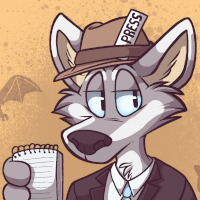PULP! Two-Pawed Tales of Adventure – book review by Fred Patten.
by kiwiztiger
Submitted by Fred Patten, Furry’s favorite historian and reviewer.
PULP! Two-Pawed Tales of Adventure, edited by Ianus J. Wolf
Las Vegas, NV, Rabbit Valley Books, September 2014, trade paperback $20.00 (255 pages).
 “The Pulps” were the rough-edged inexpensive, popular fiction magazines that were published from the late 1890s through the early 1950s, on the cheapest wood-pulp paper available. There were general-fiction magazines like All-Story and Argosy, and specialized magazines like Black Mask (mystery), Exciting Western (Western), Fight Stories (sports), G-8 and His Battle Aces (aerial warfare), Love and Romance (romance), Railroad Stories (railroad adventure), Ranch Romances (romantic Western), South Sea Stories (sea adventure), Thrilling Wonder Stories (science fiction), Weird Tales (horror), and many others. The 1920s to the ‘50s was also a period of similar weekly radio adventure-fiction dramatizations.
“The Pulps” were the rough-edged inexpensive, popular fiction magazines that were published from the late 1890s through the early 1950s, on the cheapest wood-pulp paper available. There were general-fiction magazines like All-Story and Argosy, and specialized magazines like Black Mask (mystery), Exciting Western (Western), Fight Stories (sports), G-8 and His Battle Aces (aerial warfare), Love and Romance (romance), Railroad Stories (railroad adventure), Ranch Romances (romantic Western), South Sea Stories (sea adventure), Thrilling Wonder Stories (science fiction), Weird Tales (horror), and many others. The 1920s to the ‘50s was also a period of similar weekly radio adventure-fiction dramatizations.
Now Rabbit Valley Books has recreated that era, but with anthro animal casts. Editor Ianus J. Wolf presents eight stories as though they were episodes of “The RVO Radio Evening of Adventure”.
PULP! Two-Pawed Tales of Adventure is a very mixed bag. Some of the stories are just standard adventure stories with funny-animal casts. (Boring.) Some seem to be standard adventures with funny animals, but the animal natures of the characters turn out to be pertinent. (Clever.) And some present a new kind of adventure designed for a furry world. (Admirably imaginative!) But it would be a spoiler to say which is which.
“The Ruins” by Tym Greene is an Indiana Jones-type Amazonian adventure. Liam Felton, an experienced explorer (zebra), and Stewart Brace (Dalmatian dog), an inexperienced youth but the son of the company president who ordered the expedition, search through the South American jungle for the ancient Indian temple that holds the Secret of the Gods. An unscrupulous rival, Maicon Klauss (magpie), and his hulking henchman Bernard (Clysdale horse) are ahead of them.
“Prey” by Ocean Tigrox is a Western. A nameless grizzled badger bounty hunter comes into a dusty Nevada town looking for a rabbit outlaw. “The rabbit could run but he couldn’t hide.” (p. 23) He finds that the whole town is hiding a more deadly secret. There are a vulture saloonkeeper, a bobcat mayor, an eagle sheriff and his hyena deputy, a cougar callgirl, a jackal clergyman, and more. Read the rest of this entry »











